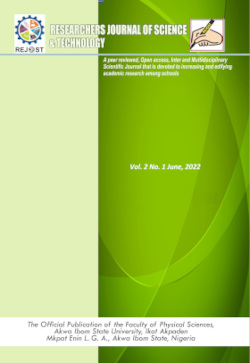Self- Cleaning Materials: Review of Recent Progress and Innovations
Keywords:
Self-cleaning, Photocatalyst, SuperhydrophobicAbstract
This paper is a review of some of the trends in the theoretical conception and development of self-cleaning materials for various applications. This review is significant as it highlights briefly the various research activities in the area of self-cleaning materials. Beyond the Wenzel, Cassie-Baxter and Young's Models that are used in theoretically examining the concept of self-cleaning, there is advancement of modelling and simulation of contact angles behaviour to include the effect of gravitational forces. Furthermore, research trends in three (3) different areas, namely; self-cleaning glasses, self-cleaning fabrics and self-cleaning cements have been discussed in some details. It has been noted that researches have focused on the use of photocatalyst, mainly TiO2 and SiO2, to generate self-cleaning surfaces that are capable of photodegrading organic matter. These photo-catalysts are added in-situ to the materials or coated on to the materials' surfaces. Different methods of coating of these photocatalysts on to the surfaces of the materials have been developed. Some of these coating methods that have seen great interest recently are the pad-dry cure and sol-gel coating methods
References
Afzal, S., Daoud, W. A. and Langford, S. J. (2014). Superhydrophobic and Photocatalytic Self-cleaning Cotton.
Journal of Materials Chemistry A, 2, 18005 – 18011.
Andalora A., Mazzucchelli E.S., Lucchini A., Pedeferri M.P., (2016), Photocatalytic selfcleaning coatings for building facade maintenance. Performance analysis through a case-study application, Journal of Facade Design and Engineering, 4, 1115- 129.
Banerjee, I., Dionysiou, D. D., and Pillai, S. C. (2015). Self-cleaning Applications of TiO2by Photo-induced Hydrophilicity and Photocatalysis. Applied Catalysis B: Environmental, 176, 396-428.
Bhushan, B and Jung, Y. C. (2011).Natural and Biomimetic Artificial Surfaces for Superhydrophobicity, Self-cleaning, Low
Adhesion and Drag Reduction. Progress in Materials Science, 56, 1-108.
Chen X., Kou S., Poon C., (2020) Rheological behaviour, mechanical performance, and NOx removal of photocatalytic mortar with combined clay brick sands-based and recycled glassbased nano-TiO2 composite photocatalysts, Construction and Building Materials, 240. 117698.
Diaa, M. and Hassabo, (2022).Self-cleaning Properties of Cellulosic Fabrics - AReview.Biointerface Research in Applied
Chemistry, 12(2), 1847-1855.
Dodiuk, H. and Kenig, S. (2009). Self-cleaning Coatings. Surface Engineering, 25(2), 89-92.
Gunnarsson, S. G. (2012). Self-cleaning Paint: Introduction of Photocatalytic Particles into a Paint System. Technical University of Denmark.
Karim, A. Fujii, K. Kavenhpour, H. (2021). Contact line dynamics of gravity driven spreading of liquids. Fluid Dynamics
Research.53(2), 035503.
Kartini, I. Santoso, S. J., Febriyanti, E., Nugroho, O. R., Yu, H., and Wang, L. (2014).Hybrid Assembly of NanosolTitania
and Dodecylamine for Superhydrophoboc Self-cleaning Glass.Journal of Nanoparticle Research, 16, 2514.
Koli V.B., Mavengere S., Kim J. (2019) An efficient one-pot N doped TiO2-SiO2synthesis and its application for
photocatalytic concrete, Applied Surface Science 491, 60–66.
Mendoza, C., Valle, A., Castellote, M., Bahamonde, A., Faraldos, M., (2015). TiO2and TiO2-SiO2 coated cement: Comparison of mechanic and photocatalytic properties, Applied Catalysis B: Environmental, 178, 155-164.
Ortelli, S., Costa, A. L. and Dondi, M. (2015). TiO2 Nanosols Applied directly on Textiles using different Purification Treatments. Materials, 8, 7988-7996
Peeters, H., Keulemans, M., Nuyts, G., Vanmeert, F., Li, C., Minjauw, M., Detavernier, C., Bals, S., Lenaerts, S. and
Verbruggen, S. W. (2020). Photocatalytic Self-cleaning Coatings with Embedded Plasmonic Gold Nanoparticles.
Shen W., Zhang C., Li Q., Zhang W., Cao L., Ye J., (2015) Preparation of titanium dioxide nano particle modified
photocatalyticselfcleaning concrete Journal of Cleaner Production, 87, 762-765.
Sivakumar, A., Murugan, R., Sundaresan, K. and Periyasamy, S. (2013). UV Protection and Self-cleaning Finish for Cotton Fabric using Metal Oxide Nanoparticles. Indian Journal of Fibre and Textile Research, 38, 285-292.
Sun, D. and Bohringer, K. F. (2019). Selfcleaning: From Bio-inspired Surface Modification to MEMS/Microfluidics
System Integration. Micromachines, 10, 101.
Topcu, I. B., Akkan, E., Uygunoglu, T. and Caliskan, K. (2020). Self-cleaning Concretes: An Overview. Journal of
Cement Based Composites, 2, 6-12.
Worasukhkhung, S., Pudwat, S., Eiamchai, P., Horprathum, M., Dumrongrattana, S. and Aiempanakit, K. (2012). Hydrophilic Property of TiO2 Films Sputtered on Glass/ITO for Self-cleaning Glass and Heat Mirror Application. Procedia Engineering,32, 780-786
Xu, Q. Zhang, W. Dong, C. Sreeprasad, S. (2016). Biomimetic Self-cleaning Surfaces: Synthesis, Mechanism and Application. Interfaces, 13, 20160300
Yi, Q., Wang, H., Cong, S., Cao, Y., Wang, Y., Sun, Y., Lou, Y., Zhao, J., Wu, J., and Zou. G. (2016). Self-cleaning Glass of
PhotocatalyticAnatase TiO2 and Carbon Nanotubes Thin Film by Polymer Assisted Approach. Nanoscale Research Letters, 11, 457.
Yuranova, T., Laub, D., Kiwi, J. (2007).Synthesis, Activity and Characterization of Textiles showing Selfcleaning Activity under Daylight Irradiation. Catalysis Today, 122, 109-117.

Downloads
Published
How to Cite
Issue
Section
Categories
License

This work is licensed under a Creative Commons Attribution-NonCommercial-NoDerivatives 4.0 International License.




